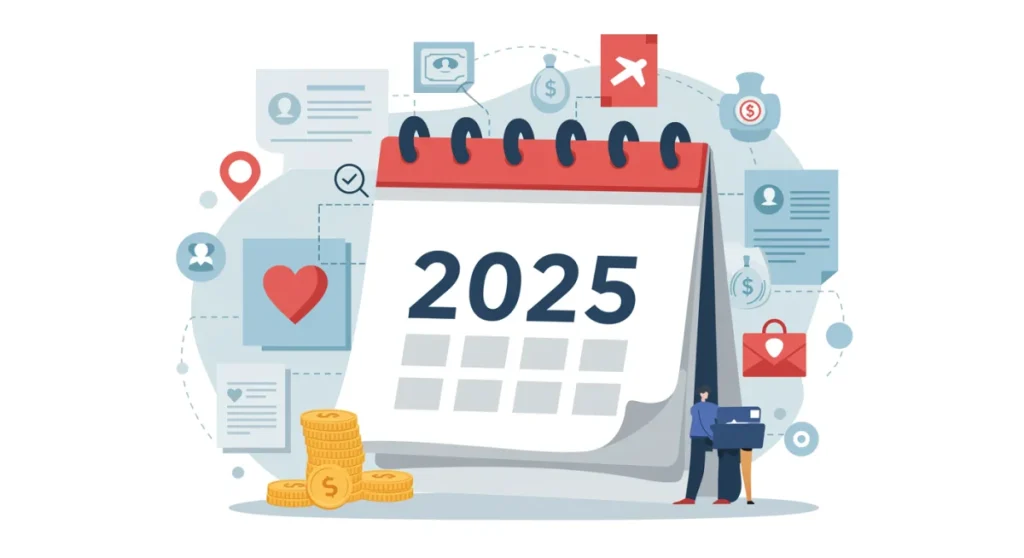2025 Employer-Sponsored Health Benefits: 5 Key Changes

Anúncios
Understanding the significant shifts in 2025 employer-sponsored health benefits is crucial for both employers and employees to navigate evolving healthcare landscapes and optimize coverage effectively.
As we approach 2025, the landscape of employer-sponsored health benefits is poised for significant transformation. For both businesses and their employees, understanding these shifts is not just beneficial, but essential for strategic planning and maintaining well-being. This article will delve into the five most impactful changes expected, helping you prepare for what’s ahead in 2025 employer-sponsored health benefits: 5 key changes to expect.
Anúncios
The Evolving Regulatory Environment and Compliance
The regulatory framework governing health benefits is a constantly moving target, and 2025 will be no exception. Employers must stay vigilant about new mandates and updates to existing laws to avoid penalties and ensure their benefit offerings remain compliant. These changes often stem from broader legislative goals aimed at improving healthcare access, affordability, and quality.
Understanding the nuances of these regulations requires a proactive approach. It’s not enough to simply react when changes are announced; anticipating potential shifts based on current legislative discussions and public health priorities can provide a significant advantage. This includes keeping an eye on federal initiatives that might influence state-level policies, creating a cascading effect on employer responsibilities.
Anúncios
Key Regulatory Updates
Several areas are expected to see significant regulatory attention. These often involve a blend of new requirements and enhanced enforcement of existing ones, particularly concerning transparency and data privacy. Employers should review their current compliance strategies to identify potential gaps.
- Increased Transparency Requirements: Expect more stringent rules around price transparency for services and prescription drugs, impacting how benefit plans are designed and communicated.
- Data Privacy and Security Enhancements: New guidelines or stricter enforcement of HIPAA and other privacy laws may require updated protocols for handling employee health information.
- Mental Health Parity Enforcement: Continued focus on ensuring mental health benefits are offered at parity with physical health benefits, potentially leading to more audits and stricter adherence.
Staying informed about these regulatory shifts is paramount for employers. Non-compliance can lead to substantial fines and reputational damage. Engaging with legal and benefits consultants who specialize in healthcare regulations can provide invaluable guidance, ensuring that benefit programs are not only compliant but also optimized to serve employee needs within the legal boundaries. This proactive engagement helps mitigate risks and fosters a more secure benefits environment.
Rising Healthcare Costs and Cost Containment Strategies
Healthcare costs continue their upward trajectory, presenting a perennial challenge for employers. In 2025, this trend is anticipated to persist, driven by factors such as inflation, new medical technologies, and the increasing prevalence of chronic conditions. Employers will need to be more strategic than ever in implementing cost containment measures without compromising the quality of care or employee satisfaction.
The pressure to manage these costs extends beyond just the bottom line; it directly impacts employee take-home pay and access to essential services. Therefore, any cost containment strategy must be carefully balanced with the need to provide competitive and valuable benefits. This often involves a multi-faceted approach that addresses various aspects of healthcare expenditure.
Innovative Benefit Design Approaches
To combat rising costs, many employers are exploring innovative ways to structure their benefit plans. These designs often aim to encourage more judicious use of healthcare services and promote preventive care, ultimately reducing overall expenses. The goal is to empower employees to make informed decisions about their health and healthcare spending.
- High-Deductible Health Plans (HDHPs) with HSAs: These plans remain popular, pairing lower premiums with tax-advantaged savings accounts that employees can use for medical expenses.
- Value-Based Care Models: Shifting towards models that reward providers for health outcomes rather than the volume of services, potentially leading to more efficient and effective care.
- Reference-Based Pricing: Setting a maximum payment for certain non-emergency medical procedures, encouraging employees to shop for more cost-effective services.
Beyond plan design, employers are also leveraging data analytics to identify areas of excessive spending and implement targeted interventions. This might include negotiating better rates with providers, offering robust wellness programs to reduce preventable conditions, or exploring direct contracting with healthcare systems. The focus is on creating a sustainable benefits program that delivers value for both the employer and the employee, mitigating the impact of ever-increasing healthcare expenses.
Increased Focus on Mental Health and Well-being
The importance of mental health and overall employee well-being has gained significant traction, moving from a secondary concern to a core component of comprehensive benefits packages. This heightened awareness, accelerated by recent global events, means that in 2025, employers are expected to significantly enhance their offerings in this area. It’s recognized that a healthy workforce, both mentally and physically, is a productive workforce.
This shift isn’t just about offering more services; it’s about integrating mental health support into the broader organizational culture. It involves reducing stigma, promoting open dialogue, and ensuring easy access to resources. Employers are realizing that investing in mental well-being can lead to reduced absenteeism, improved engagement, and higher retention rates.
Expanded Mental Health Services
Expect to see a broader array of mental health services included in employer-sponsored plans, moving beyond basic counseling to more specialized and accessible options. The aim is to meet employees where they are and provide support that fits diverse needs and preferences.
- Telehealth for Mental Health: Continued expansion of virtual therapy and psychiatric services, offering convenience and accessibility, especially in underserved areas.
- Employee Assistance Programs (EAPs): Enhanced EAPs with more robust offerings, including financial counseling, legal advice, and critical incident support, alongside traditional mental health services.
- Mindfulness and Stress Reduction Programs: Integration of wellness apps, workshops, and resources focused on resilience, mindfulness, and stress management into benefit packages.

Employers are also recognizing the need for a holistic approach to well-being, encompassing physical, mental, and financial health. This integrated strategy acknowledges that these aspects are interconnected and that challenges in one area can impact others. Providing resources that address all facets of employee well-being creates a more supportive and resilient workplace, fostering an environment where employees can thrive both personally and professionally.
Personalization and Digitalization of Benefits
The one-size-fits-all approach to benefits is rapidly becoming outdated. In 2025, a significant trend will be the increased personalization of health benefits, coupled with the widespread adoption of digital platforms to deliver and manage these offerings. This shift is driven by a desire to meet the diverse needs of a multi-generational workforce and to provide a more engaging and user-friendly benefits experience.
Digital tools are transforming how employees interact with their benefits, offering greater control, transparency, and convenience. From selecting plans to accessing care, technology is streamlining processes and making healthcare more accessible. This digitalization also provides employers with valuable data to refine their offerings and better understand employee preferences.
Tailored Benefit Offerings and Platforms
Employers are moving towards offering more choice and flexibility, allowing employees to customize their benefits packages to better suit their individual circumstances and life stages. This bespoke approach enhances perceived value and utilization.
- Flexible Benefit Platforms: Digital portals that allow employees to easily compare, select, and manage their benefits, often with decision-support tools.
- Personalized Wellness Programs: Customized wellness initiatives based on individual health data and preferences, offering targeted support for specific health goals.
- Virtual Care Integration: Seamless integration of telehealth, virtual primary care, and remote monitoring services into benefit plans for convenient access to medical advice and treatment.
The move towards personalization and digitalization is not just about convenience; it’s about empowering employees to take a more active role in their health management. By providing intuitive digital platforms and a wider array of customizable options, employers can foster a sense of ownership and engagement. This leads to better health outcomes, higher satisfaction, and a more efficient administration of benefits, aligning with the evolving expectations of today’s workforce.
Emphasis on Preventive Care and Chronic Disease Management
A fundamental shift in healthcare strategy is the growing emphasis on preventive care and proactive chronic disease management. Recognizing that prevention is often more effective and less costly than treatment, employers in 2025 will increasingly invest in programs and benefits that encourage healthy lifestyles and early intervention. This approach aims to improve long-term health outcomes for employees while simultaneously reducing overall healthcare expenditures.
Chronic diseases, such as diabetes, heart disease, and hypertension, account for a significant portion of healthcare costs. By providing robust support for managing these conditions, employers can help employees lead healthier lives and minimize the impact of these illnesses on productivity and healthcare utilization. This proactive stance benefits both the individual and the organization.
Proactive Health Initiatives
Benefit programs are evolving to include more components focused on preventing illness and effectively managing existing chronic conditions. These initiatives often combine educational resources with practical support and incentives.
- Wellness Incentives: Rewards for participating in health screenings, engaging in physical activity, or achieving specific health goals, promoting healthy behaviors.
- Chronic Care Management Programs: Specialized programs providing coaching, education, and support for employees managing chronic conditions, aiming for better health control.
- Preventive Screenings and Immunizations: Ensuring easy access and full coverage for recommended screenings (e.g., mammograms, colonoscopies) and vaccinations to detect and prevent diseases early.
The strategic investment in preventive care and chronic disease management is a win-win. Employees benefit from improved health and quality of life, while employers see the advantages of a healthier, more engaged workforce and reduced healthcare costs over time. This forward-thinking approach is becoming a cornerstone of sustainable and responsible employer-sponsored health benefits, setting the stage for a healthier future for all.
| Key Change | Brief Description |
|---|---|
| Regulatory Evolution | New compliance requirements for transparency, privacy, and mental health parity. |
| Cost Containment | Innovative plan designs and strategies to manage rising healthcare expenses. |
| Mental Health Focus | Expanded services and integrated well-being programs for employee mental health. |
| Personalization & Digitalization | Customized benefits and digital platforms for enhanced user experience and access. |
Frequently Asked Questions About 2025 Health Benefits
Expect increased transparency requirements for pricing, stricter data privacy guidelines, and enhanced enforcement of mental health parity laws. Employers will need to actively update their compliance strategies to meet these evolving federal and state mandates.
Employers can implement strategies like high-deductible health plans with HSAs, explore value-based care models, and utilize reference-based pricing. Investing in robust wellness programs and leveraging data analytics also helps identify and address cost drivers effectively.
Yes, 2025 is expected to see a greater emphasis on mental health benefits and well-being. This includes expanded telehealth options for therapy, more comprehensive Employee Assistance Programs (EAPs), and the integration of stress reduction and mindfulness initiatives into benefit packages.
Digitalization will be crucial, offering personalized benefit platforms that allow employees to customize their plans. Expect seamless integration of virtual care services, digital wellness programs, and data-driven insights to enhance accessibility and user experience in managing benefits.
Preventive care and chronic disease management are gaining importance because they improve long-term employee health outcomes and reduce overall healthcare costs. Employers are investing in wellness incentives and specialized programs to encourage healthy behaviors and early intervention, creating a healthier workforce.
Conclusion
The year 2025 promises a dynamic evolution in employer-sponsored health benefits, marked by significant changes across regulatory compliance, cost management, mental health support, technological integration, and a renewed focus on preventive care. Employers who proactively adapt to these shifts will not only ensure compliance and financial stability but also cultivate a more engaged, healthier, and productive workforce. Staying informed and strategically planning for these transformations will be key to successfully navigating the future of healthcare benefits.





